-
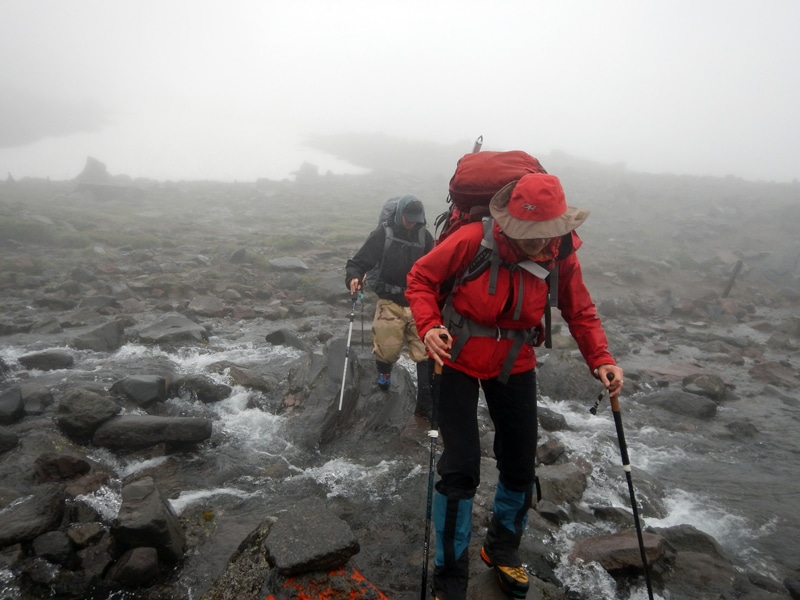
There’s A Reason It’s Called “Climbing” And Not “Summiting”
For the first time in the 7 years we’ve run the Climbing Out Of Homelessness Program, Mt. Rainier got stingy and denied us (and everyone else climbing that night) the summit.
We met in Ashford on Saturday, August 12th for final gear check, and to get whatever gear the team lacked, courtesy of Rainier Mountaineering, who has opened their rental counter to us at no charge since the beginning.
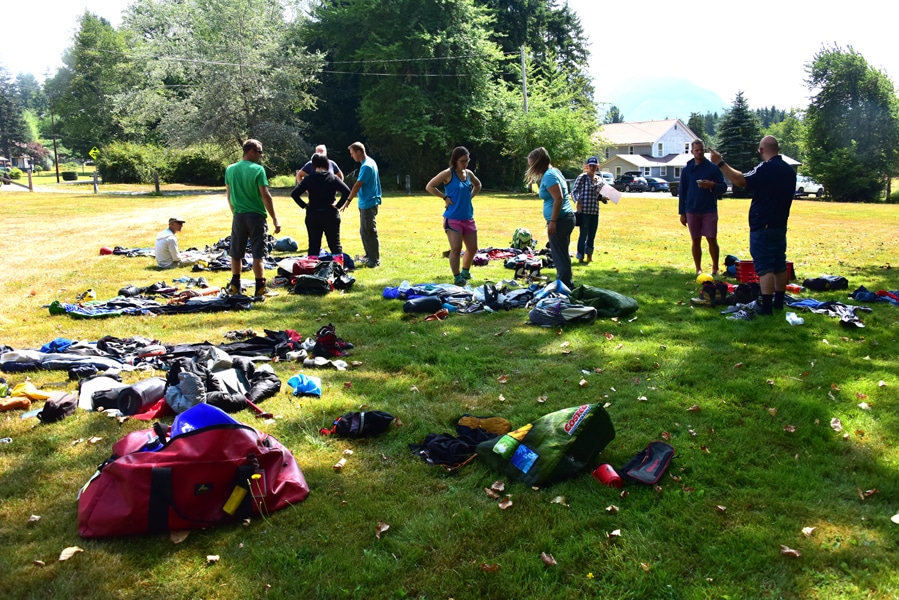
Gear Check Before Climb
At our annual pre-climb dinner at the Wild Berry Restaurant in Ashford, we caught wind of a huge collapse on the upper mountain on Rainier. We didn’t know what to make of it, but it didn’t sound good. The more we heard, the worse it sounded. It didn’t dampen our festival mood at the dinner, though, and we had our usual presentation of engraved ice axes to our Program Climbers.
We also had our annual “Sundae” and “Cherry” conversation. That is to say, the climbers have already had the sundae – the program and sense of team and accomplishment getting through the training, climbing Mt. Hood, spending the night on Mt. Rainier during our final climb simulation – this is your 3 scoops of ice cream. The summit is the much desired cherry on top, but whether they get that final reward or not, they’ve gotten the sundae.
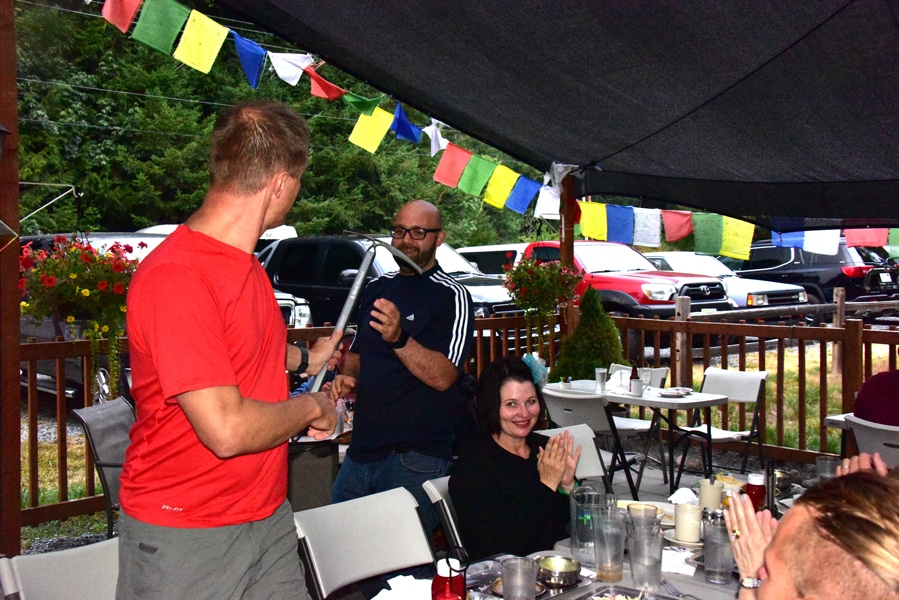
Mike presents an axe to Matthew at the pre-climb dinner.
We woke on Sunday to a persistent mist and a very soggy mountain.
Camp Muir was just at the top of the clouds, though, so we were dry, and pretty much in the clear as we set up camp.
I met with Jason, one of our volunteer guides, and the person responsible for coordinating the efforts of the 3 guide services who are licensed to guide the Disappointment Cleaver route on Mt. Rainier, as well as commissioned with maintenance of the route. He told me that they had no idea if or when they might find a route past the trouble to the summit. He also let me know that he and Phil (another of our volunteer guides) would most likely be tied up working on the route, and wouldn’t be able to help us with the climb. I told him that I’d already figured that would be the case, and was working out contingency plans – none of which could result in all of us making a summit attempt.
We had dinner, and went to bed, knowing only that in the morning, the team would be going through another round of “Basic Snow School”, this time with Leon (our climb leader for the past several years) and Lindsay (who has been a key volunteer guide since 2013 as well).
Monday morning, the team got up, breakfasted, and hit the snowfield for their training with Leon and Lindsay. Meanwhile, when asking Jason about the situation on the mountain, he said that it could be summed up in two words, “Totally @#${637c4c527fde39f83a380e19107d2ba88ad72607f37ccf8f8b7edeff1c20688c}ed”.
“Meanwhile, when asking Jason about the situation on the mountain, he said that it could be summed up in two words, ‘Totally @#${637c4c527fde39f83a380e19107d2ba88ad72607f37ccf8f8b7edeff1c20688c}ed’.”
Since it didn’t look like there was going to be a route to the summit, Leon and Lindsay came up with a plan to take the team to Ingraham Flats (the first stop up from Camp Muir) the next morning as a way to allow them to experience and see more of the mountain, and perhaps lowering them into a crevasse just for giggles. It’s actually a pretty cool experience.
The team was disappointed at not getting a shot at the summit, some VERY disappointed, even though they had been prepared for the possibility. But the mountain rules.
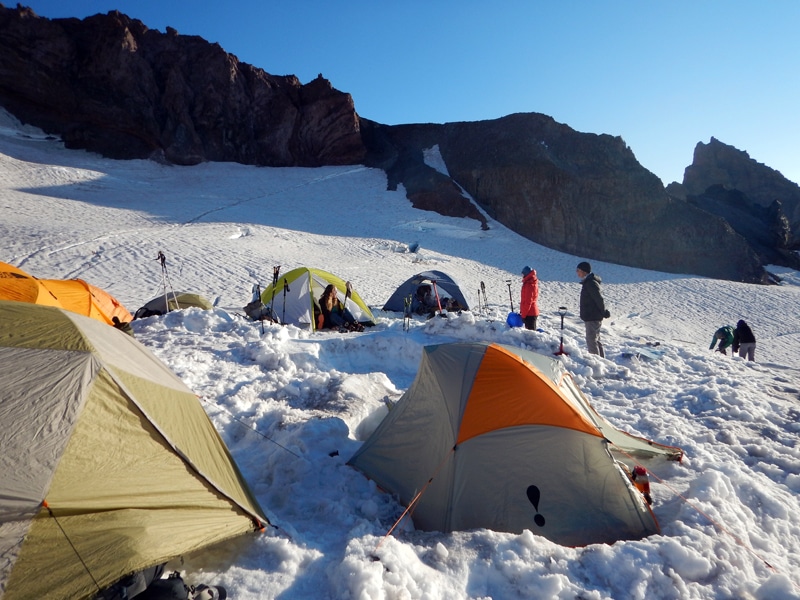
Our Camp At Muir
Just before the team went to bed, we received word that two professional guides had made it to the summit. That didn’t mean that there was a route that your average climber (much less a pack of newbies) could climb successfully, but it did mean there was some kind of a shot – maybe. So the team went to bed knowing there was a SMALL chance they might get awakened at 11 pm to climb, but most likely they’d get woken up later in the morning to climb to the Flats.
After the team went to bed, more guides headed up the mountain to try to at least heavily mark the route. Leon told us to keep our radios on, and he and Lindsay would make the call on the climb “later.”
Just before 11 pm, we got the call from Leon that he didn’t have any news from higher on the mountain, but he thought the Program Team should give it a shot. We rousted the climbers, had breakfast, got everyone geared up, and sent them out.
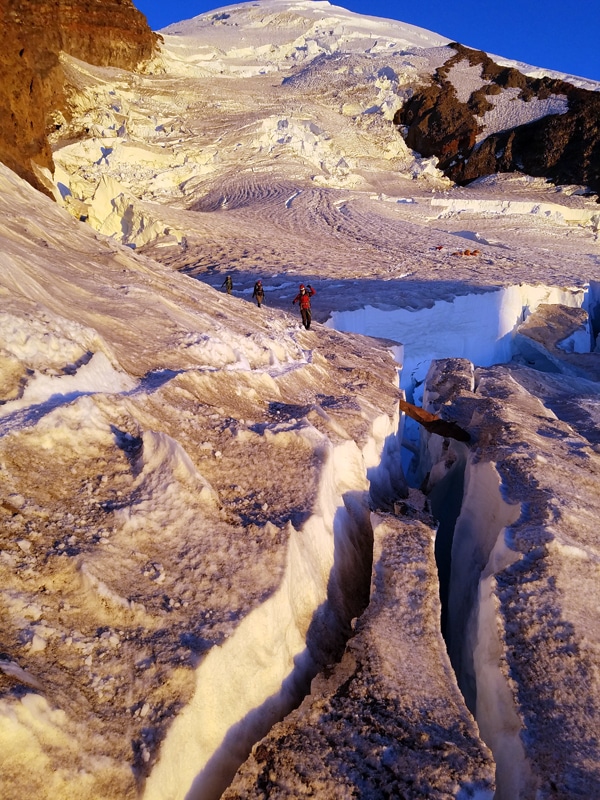
The climb team on Ingraham Glacier.
Even before the snow plug collapse, the route had been unusually long, hitting the summit in a spot no one (even long-time mountain guides) ever remembered it going. After the collapse, it was not only long, but hit a spot of mountain that was deeply sun-cupped into formations that are called “penitents” because the formations kind of look like people on their knees in prayer – thousands and thousands of people. They are very difficult to traverse, because there is no flat footing (at any angle), and you climb over and through the sun cups. There is no efficient way to climb, and the going is VERY slow.
The RMI guided group ahead of our group turned around just above 13,000’. Our team followed suit. The final push to the summit was going to take more than 2 hours, and being already over 5 hours into the climb, there was concern about people having the ‘gas’ to get down safely. Remember, the goal isn’t to get to the top, it’s to get back to the bottom – via the top if possible, but the top is optional, the bottom is not.
Everyone came off of the climb MUCH happier that they at least had taken a shot at the summit, and having gone through what they’d gone through, and seeing what they saw, knew that they had given it their best shot, and the mountain just wasn’t giving it up. No one summited that night, and I don’t believe anyone summited the next night either.
“Many of us throughout life need lessons in how to deal with disappointment constructively. And I think this team did.”
Not reaching the summit was disappointing for all of us, but the climb was a success. In some ways, maybe even a bigger success for NOT having summited. Many of us throughout life need lessons in how to deal with disappointment constructively. And I think this team did.
7 -
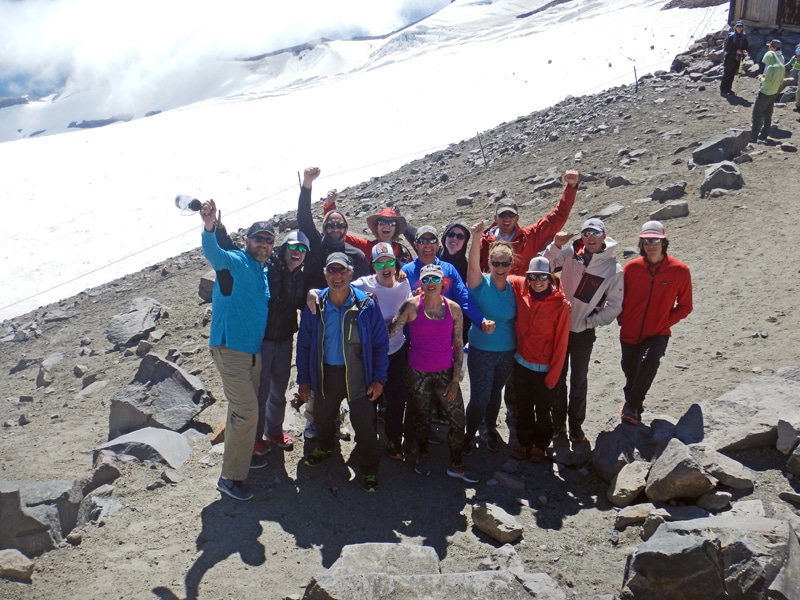
Our Relationships Are Our Summit
After our first year, we interviewed our recovery climbers. Every one of them said that the team experience was more meaningful to them than the summit itself. So we re-focused the program to emphasize team building and healthy relationships. We added community climbers alongside those climbing out of homelessness.
This year was the first year we had no effective route to the summit, and the emphasis on team-building paid huge dividends. We may not have been able to reach the mountain’s highest point, but the relationships were a true “high point” for all involved…and more enduring!
Life really is about relationships, and so is climbing. Our senior guide and friend Leon Davis was asked by one of our recovery climbers which mountain was his favorite to climb. He said, “I don’t think I have a favorite mountain, but I have had some favorite outings. Those really were about who I was with.” That’s what we got this year, Leon: and it really is the true summit.
-
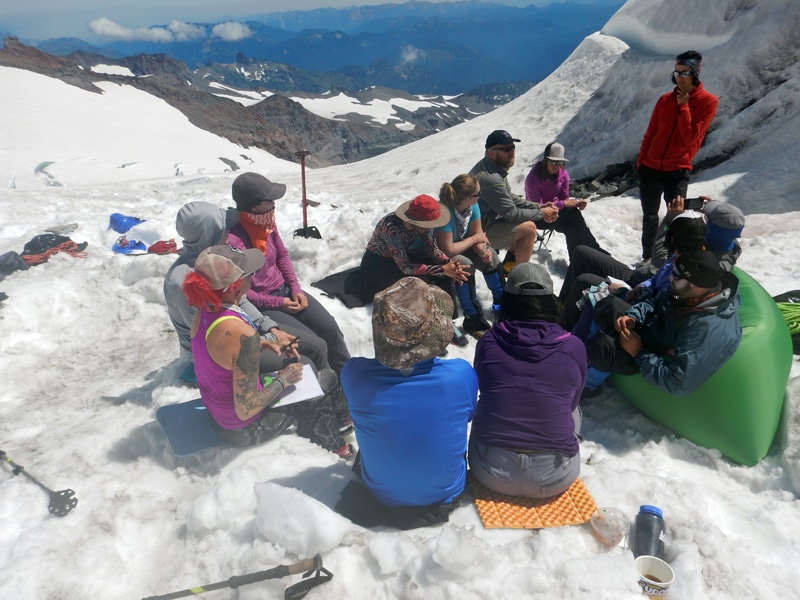
Going Home – Seattle’s Union Gospel Mission
They say ‘you can never go home’, but that’s exactly what we are doing. This fall the Climbing Out of Homelessness Program will return to Seattle’s Union Gospel Mission. Our partnership with UGM began in 2011, based on a need to enhance the addiction recovery program. Taking a crazy idea that shakes up the perception of people by endeavoring to climb a mountain. Little did we know at the time, what a great metaphor that would become, both figuratively and literally. This isn’t just another physical fitness program; it’s a community way of helping our neighbors overcome the challenges of all types of addiction. Help us celebrate this homecoming by making a tax deductible donation today.
-
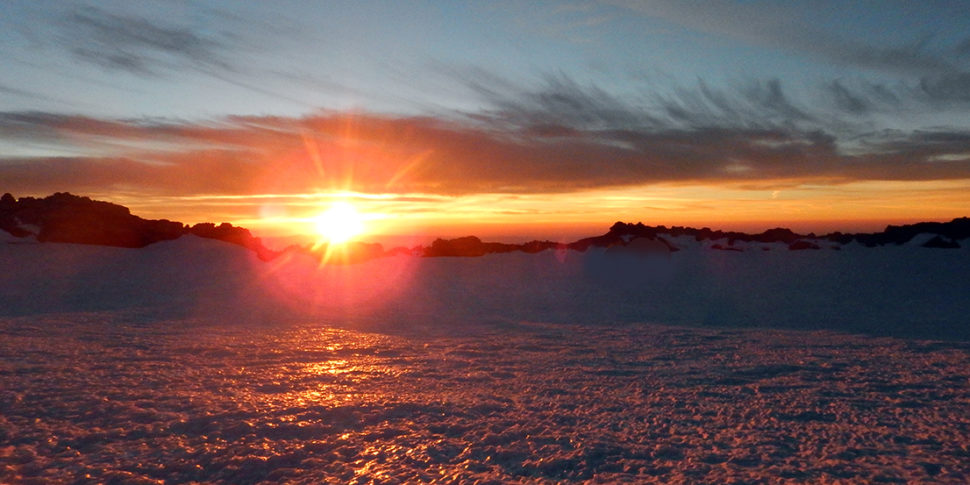
Join our Community of Compassion
Consider joining our Community of Compassion. By making an ongoing monthly donation of $20, you can give a new way of life for our program climbers. There are many ways to give, please see other suggestions on our website at https://recoverybp.org/how-you-can-help/
Changing the face of homelessness is really up to us. We support climbers in a number of ways. You may already be supporting one of the missions doing great work to alleviate addiction and its consequences. Our Climbing Out of Homelessness program helps make long lasting change possible. A community of compassion and support makes all the difference for the success of recovery. None of us achieve anything significant without the support of community. Our community is the key to this wonderful transformation.
-
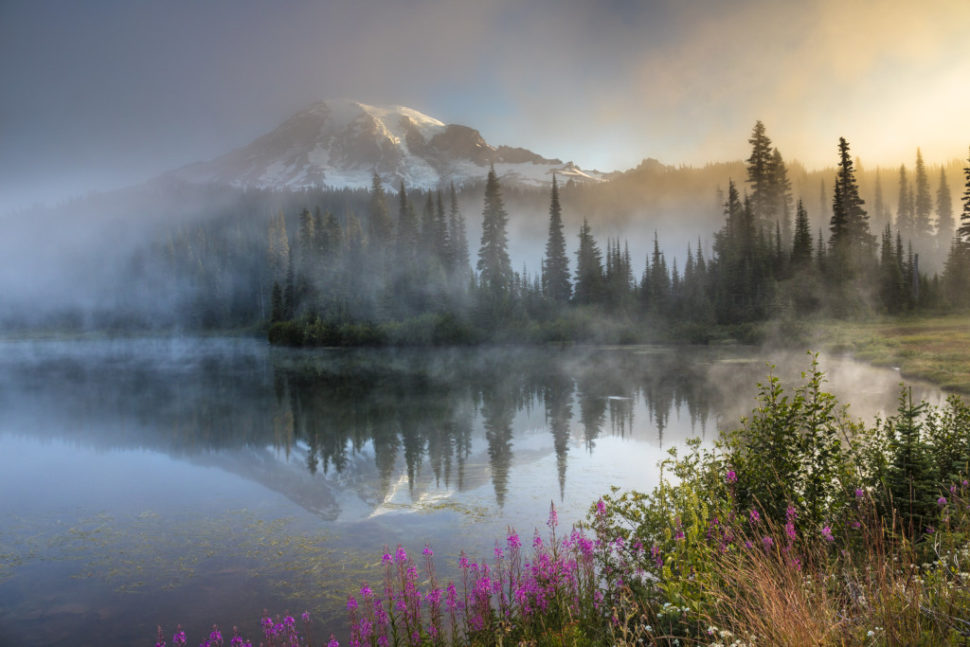
Celebrating a New Beginning
On Saturday, August 12th our climbing team gathered for the pre-climb dinner at Wild Berry Restaurant in Ashford, Washington at the base of Mount Rainier. The next morning this jubilant group would start the final climb of the year, up 14,411 feet of Mount Rainier, one of the highest peaks in the continental US.
To say they were excited would be a gross understatement. To say that they were amazed at the 10 months of progress they had made would be much more truthful. As a group, the program and volunteer climbers were in a state of awe. Even though the actual climb was a day away, this was the culminating event; the place where each person was recognized for how far they had come and for the truly wondrous person they were becoming.
The relationships that form on this journey of healing to wholeness are the most satisfying and predictable part of the transformation each person has undergone. I chose this headliner quote from Matthew Kelly because it sums up the essence of our whole approach to partnering in the treatment and therapy that each person needs to find during their recovery process toward the life they were meant to live. Truly “when we reveal our faults and failings, … people do begin to love us” and at a much deeper level. Perhaps even for the first time in our lives.
“When we reveal our faults and failings, … people do begin to love us” – Matthew Kelly
Maybe in a way that we are now more prepared to accept; in our brokenness we begin to understand why we need each other. The love expressed was deeply humbling and beautifully expressed. Sometimes it’s in the little things that happened during preparatory events or it was in the deep bond that had formed from personal needs being meant on both sides of the relationship. Other times it was in the deep and trusting bond that helped someone realize the potential for good they had inside.
The value of each life and the contribution one can make, no matter when you start. The realization was a huge part of the transformative process the Climbing Out program tries to offer.
The mere fact that ‘strangers’ bonded so completely and that the transformations we witness are so astounding, is a blessing. A blessing for all who are part of this program and who are able to view the changes, the challenges and glorious successes our climbers spoke about Saturday night.
Life is very hard for someone who ends up on the streets homeless after experiencing the tragic impact of drug or alcohol abuse. This outcome is not what they planned or even what they wanted; but the ability to climb out of that situation takes the same drive, guts and effort that is does to climb a 14,000 foot mountain.
As a society, we do not make it any easier for them either. As a society, we are to blame oftentimes for the series of blows that causes someone to fall this far; and we are also responsible for providing the solutions to help this pattern be reversed; to even prevent it from happening to others to begin with.
Recovery Beyond’s mission is “To develop, fund, and deliver programs, services, or items that complement the efforts of established recovery/homelessness programs in unconventional ways.”
We ask you to join our Community of Compassion by becoming involved, by helping us continue to expand and offer programs that actually are getting results to help even more people and offered through more missions. Please visit our donate page to see who you can be responsible for delivering winning solutions.
More about the climb’s outcome in our upcoming newsletter and later blogs. Sign up to receive our newsletter below.
Make An Impact, Get Involved. Change Lives Today.
Photo credit: Art Wolf
